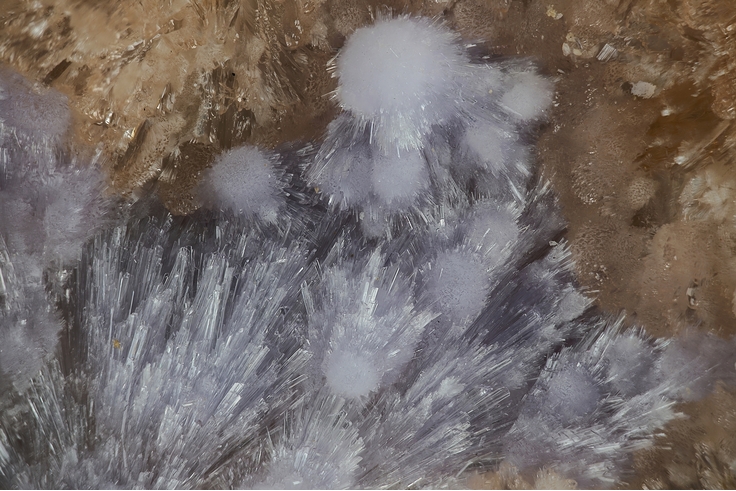Geigerite
A valid IMA mineral species
This page is currently not sponsored. Click here to sponsor this page.
About Geigerite
Formula:
Mn2+5(AsO4)2(HAsO4)2 · 10H2O
Colour:
Very faint rose-red color. Isolated crystals appear almost colorless.
Lustre:
Vitreous, Pearly
Hardness:
3
Specific Gravity:
3.05
Crystal System:
Triclinic
Member of:
Name:
Named after Dr. Thomas Geiger (1920 - 1990), Swiss mineralogist and metallurgist in the machinery industry and specialist for the manganese ores and minerals of Falotta and Alp Parsettens to which he devoted his PhD thesis and a series of later studies.
Unique Identifiers
Mindat ID:
1669
Long-form identifier:
mindat:1:1:1669:4
GUID
(UUID V4):
(UUID V4):
26d9b9fc-0ff5-4e85-b748-72d54e4eda13
IMA Classification of Geigerite
Approved
IMA Formula:
Mn2+5(AsO4)2(AsO3OH)2 · 10H2O
Approval year:
1985
First published:
1989
Classification of Geigerite
8.CE.05
8 : PHOSPHATES, ARSENATES, VANADATES
C : Phosphates without additional anions, with H2O
E : With only medium-sized cations, RO4:H2O about 1:2.5
8 : PHOSPHATES, ARSENATES, VANADATES
C : Phosphates without additional anions, with H2O
E : With only medium-sized cations, RO4:H2O about 1:2.5
39.2.6.2
39 : HYDRATED ACID PHOSPHATES,ARSENATES AND VANADATES
2 : (AB)5[HXO4]2[XO4]2.xH2O
39 : HYDRATED ACID PHOSPHATES,ARSENATES AND VANADATES
2 : (AB)5[HXO4]2[XO4]2.xH2O
20.8.10
20 : Arsenates (also arsenates with phosphate, but without other anions)
8 : Arsenates of Mn
20 : Arsenates (also arsenates with phosphate, but without other anions)
8 : Arsenates of Mn
Mineral Symbols
As of 2021 there are now IMA–CNMNC approved mineral symbols (abbreviations) for each mineral species, useful for tables and diagrams.
| Symbol | Source | Reference |
|---|---|---|
| Ggr | IMA–CNMNC | Warr, L.N. (2021). IMA–CNMNC approved mineral symbols. Mineralogical Magazine, 85(3), 291-320. doi:10.1180/mgm.2021.43 |
Physical Properties of Geigerite
Vitreous, Pearly
Transparency:
Transparent
Colour:
Very faint rose-red color. Isolated crystals appear almost colorless.
Streak:
White
Hardness:
3 on Mohs scale
Hardness:
VHN20=105 kg/mm2 - Vickers
Comment:
VHN,50g = 115 kg/mm3
Tenacity:
Very brittle
Cleavage:
Perfect
Parallel to {010}
Parallel to {010}
Density:
3.05(10) g/cm3 (Measured) 3.00 g/cm3 (Calculated)
Comment:
Measured using heavy liquids
Optical Data of Geigerite
Type:
Biaxial (-)
RI values:
nα = 1.601 nβ = 1.630 nγ = 1.660
2V:
Measured: 89° , Calculated: 88°
Max Birefringence:
δ = 0.059

Image shows birefringence interference colour range (at 30µm thickness)
and does not take into account mineral colouration.
and does not take into account mineral colouration.
Surface Relief:
Moderate
Dispersion:
none
Optical Extinction:
Z > Y ~ X.
Pleochroism:
Weak
Comments:
Very weakly visible in thicker crystals, colorless to rose-red.
Comments:
X ~ b, Y ~ a, Z ~ c. On {010}: Z Λ c~ 15°, on {100}: Z Λ c~ 6°, X almost normal to {010}.
Chemistry of Geigerite
Mindat Formula:
Mn2+5(AsO4)2(HAsO4)2 · 10H2O
Elements listed:
Crystallography of Geigerite
Crystal System:
Triclinic
Class (H-M):
1 - Pinacoidal
Space Group:
P1
Cell Parameters:
a = 7.94 Å, b = 10.69 Å, c = 6.77 Å
α = 80.97°, β = 84.2°, γ = 81.85°
α = 80.97°, β = 84.2°, γ = 81.85°
Ratio:
a:b:c = 0.743 : 1 : 0.633
Unit Cell V:
560.3 ų
Z:
1
Morphology:
Platy on {010}, with striation parallel to the c axis
Crystal Structure
Load
Unit Cell | Unit Cell Packed
2x2x2 | 3x3x3 | 4x4x4
Unit Cell | Unit Cell Packed
2x2x2 | 3x3x3 | 4x4x4
Show
Big Balls | Small Balls | Just Balls | Spacefill
Polyhedra Off | Si Polyhedra | All Polyhedra
Remove metal-metal sticks
Big Balls | Small Balls | Just Balls | Spacefill
Polyhedra Off | Si Polyhedra | All Polyhedra
Remove metal-metal sticks
Display Options
Black Background | White Background
Perspective On | Perspective Off
2D | Stereo | Red-Blue | Red-Cyan
Black Background | White Background
Perspective On | Perspective Off
2D | Stereo | Red-Blue | Red-Cyan
View
CIF File Best | x | y | z | a | b | c
CIF File Best | x | y | z | a | b | c
Rotation
Stop | Start
Stop | Start
Labels
Console Off | On | Grey | Yellow
Console Off | On | Grey | Yellow
Data courtesy of the American Mineralogist Crystal Structure Database. Click on an AMCSD ID to view structure
| ID | Species | Reference | Link | Year | Locality | Pressure (GPa) | Temp (K) |
|---|---|---|---|---|---|---|---|
| 0001248 | Geigerite | Graeser S, Schwander H, Bianchi R, Pilati T, Gramaccioli C M (1989) Geigerite, the Mn analogue of chudobaite: Its description and crystal structure American Mineralogist 74 676-684 |  | 1989 | 0 | 293 |
CIF Raw Data - click here to close
X-Ray Powder Diffraction
Powder Diffraction Data:
| d-spacing | Intensity |
|---|---|
| 10.45 Å | (100) |
| 7.85 Å | (13) |
| 3.507 Å | (21) |
| 3.340 Å | (20) |
| 3.051 Å | (24) |
| 3.011 Å | (17) |
| 2.786 Å | (14) |
Geological Environment
Paragenetic Mode(s):
| Paragenetic Mode | Earliest Age (Ga) |
|---|---|
| Stage 7: Great Oxidation Event | <2.4 |
| 47a : [Near-surface hydration of prior minerals] | |
| 47d : [Arsenates, antimonates, selenates, bismuthinates] | |
| 47e : [Vanadates, chromates, manganates] |
Type Occurrence of Geigerite
General Appearance of Type Material:
Covers the rock in minute crystals, rarely exceeding 0.5 mm in length, on areas of the order of 1 cm2. Also, massive, fine-grained to fibrous aggregates up to 1 cm in length.
Place of Conservation of Type Material:
Natural History Museum, Basel, and at the Mineralogical Institute, University of Basel.
Geological Setting of Type Material:
Alpine metamorphism of manganese ores, with abundant As in surrounding rock
Reference:
Graeser, S., Schwander, H., Bianchi, R., Pilati, T., Gramaccioli, C.M. (1989) Geigerite, the manganese analogue of chudobaite: Its description and crystal structure. American Mineralogist: 74: 676-684.
Synonyms of Geigerite
Other Language Names for Geigerite
Relationship of Geigerite to other Species
Member of:
Other Members of this group:
| Chudobaite | (Mg,Zn)5(AsO4)2(HAsO4)2 · 10H2O | Tric. 1 : P1 |
| Klajite | MnCu4(AsO4)2(HAsO4)2 · 9-10H2O | Tric. 1 : P1 |
| Ondrušite | CaCu4(AsO4)2(HAsO4)2 · 10H2O | Tric. 1 : P1 |
Common Associates
Associated Minerals Based on Photo Data:
| 2 photos of Geigerite associated with Villyaellenite | MnMn2Ca2(AsO4)2(HAsO4)2 · 4H2O |
| 1 photo of Geigerite associated with Calcite | CaCO3 |
| 1 photo of Geigerite associated with Manganese Oxides | |
| 1 photo of Geigerite associated with Sarkinite | Mn2+2(AsO4)(OH) |
Related Minerals - Strunz-mindat Grouping
| 8.CE.X | Babánekite | Cu3(AsO4)2 · 8H2O |
| 8.CE. | Monteneroite | Cu2+Mn2+2(AsO4)2 · 8H2O |
| 8.CE.05 | Chudobaite | (Mg,Zn)5(AsO4)2(HAsO4)2 · 10H2O |
| 8.CE.10 | Newberyite | Mg(PO3OH) · 3H2O |
| 8.CE.15 | Brassite | Mg(HAsO4) · 4H2O |
| 8.CE.20 | Phosphorrösslerite | Mg(PO3OH) · 7H2O |
| 8.CE.20 | Rösslerite | Mg(HAsO4) · 7H2O |
| 8.CE.25 | Metaswitzerite | Mn2+3(PO4)2 · 4H2O |
| 8.CE.25 | Switzerite | Mn2+3(PO4)2 · 7H2O |
| 8.CE.30 | Lindackerite | CuCu4(AsO4)2(HAsO4)2 · 9H2O |
| 8.CE.30 | Ondrušite | CaCu4(AsO4)2(HAsO4)2 · 10H2O |
| 8.CE.30 | Veselovskýite | ZnCu4(AsO4)2(HAsO4)2 · 9H2O |
| 8.CE.30 | Pradetite | CoCu4(AsO4)2(HAsO4)2 · 9H2O |
| 8.CE.30 | Klajite | MnCu4(AsO4)2(HAsO4)2 · 9-10H2O |
| 8.CE.30 | Hloušekite | (Ni,Co)Cu4(AsO4)2(AsO3OH)2 · 9H2O |
| 8.CE.35 | Bobierrite | Mg3(PO4)2 · 8H2O |
| 8.CE.40 | Annabergite | Ni3(AsO4)2 · 8H2O |
| 8.CE.40 | Arupite | Ni3(PO4)2 · 8H2O |
| 8.CE.40 | Barićite | (Mg,Fe)3(PO4)2 · 8H2O |
| 8.CE.40 | Erythrite | Co3(AsO4)2 · 8H2O |
| 8.CE.40 | Ferrisymplesite | Fe3+3(AsO4)2(OH)3 · 5H2O |
| 8.CE.40 | Hörnesite | Mg3(AsO4)2 · 8H2O |
| 8.CE.40 | Köttigite | Zn3(AsO4)2 · 8H2O |
| 8.CE.40 | Manganohörnesite | Mn2+3(AsO4)2 · 8H2O |
| 8.CE.40 | Parasymplesite | Fe2+3(AsO4)2 · 8H2O |
| 8.CE.40 | Vivianite | Fe2+Fe2+2(PO4)2 · 8H2O |
| 8.CE.40 | Pakhomovskyite | Co3(PO4)2 · 8H2O |
| 8.CE.45 | Symplesite | Fe2+3(AsO4)2 · 8H2O |
| 8.CE.50 | Cattiite | Mg3(PO4)2 · 22H2O |
| 8.CE.55 | Koninckite | Fe3+PO4 · 3H2O |
| 8.CE.60 | Kaňkite | FeAsO4 · 3.5H2O |
| 8.CE.60 | Hilarionite | Fe3+2(SO4)(AsO4)(OH) · 6H2O |
| 8.CE.65 | Steigerite | Al(VO4) · 3H2O |
| 8.CE.70 | Metaschoderite | Al2(PO4)(VO4) · 6H2O |
| 8.CE.70 | Schoderite | Al2(PO4)(VO4) · 8H2O |
| 8.CE.75 | Malhmoodite | FeZr(PO4)2 · 4H2O |
| 8.CE.75 | Zigrasite | MgZr(PO4)2 · 4H2O |
| 8.CE.75 | UM2009-11-PO:CaHZr | CaZr[PO4]2 · 4H2O |
| 8.CE.80 | Santabarbaraite | Fe3+3(PO4)2(OH)3 · 5H2O |
| 8.CE.85 | Metaköttigite | (Zn,Fe,Fe)3(AsO4)2 · 8(H2O,OH) |
| 8.CE.90 | Slavkovite | Cu13(AsO4)6(AsO3OH)4 · 23H2O |
Fluorescence of Geigerite
None
Other Information
IR Spectrum:
cm-1, transmittance in percent:
3428 (27.6), 1643 (74.5), 824 (27.6),714 (61.1), 400 (48.3), and 370 (47.3).
3428 (27.6), 1643 (74.5), 824 (27.6),714 (61.1), 400 (48.3), and 370 (47.3).
Health Risks:
No information on health risks for this material has been entered into the database. You should always treat mineral specimens with care.
Internet Links for Geigerite
mindat.org URL:
https://www.mindat.org/min-1669.html
Please feel free to link to this page.
Please feel free to link to this page.
Search Engines:
External Links:
Mineral Dealers:
References for Geigerite
Reference List:
Localities for Geigerite
Locality List
 - This locality has map coordinates listed.
- This locality has map coordinates listed.
 - This locality has estimated coordinates.
ⓘ - Click for references and further information on this occurrence.
? - Indicates mineral may be doubtful at this locality.
- This locality has estimated coordinates.
ⓘ - Click for references and further information on this occurrence.
? - Indicates mineral may be doubtful at this locality.
 - Good crystals or important locality for species.
- Good crystals or important locality for species.
 - World class for species or very significant.
(TL) - Type Locality for a valid mineral species.
(FRL) - First Recorded Locality for everything else (eg varieties).
- World class for species or very significant.
(TL) - Type Locality for a valid mineral species.
(FRL) - First Recorded Locality for everything else (eg varieties).
All localities listed without proper references should be considered as questionable.
Italy | |
| |
Japan | |
| |
| |
Romania | |
| |
Saudi Arabia | |
| |
Switzerland (TL) | |
| |
|
Quick NavTopAbout GeigeriteUnique IdentifiersIMA Classification Classification Mineral SymbolsPhysical Properties Optical Data Chemistry Crystallography Crystal StructureX-Ray Powder DiffractionGeological EnvironmentType Occurrence SynonymsOther LanguagesRelationshipsCommon AssociatesStrunz-MindatFluorescence Other InformationInternet Links References Localities Locality List







 symbol to view information about a locality.
The
symbol to view information about a locality.
The 



Săcărâmb, Certeju de Sus, Hunedoara County, Romania